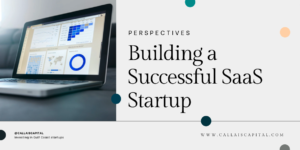
By Callais Team
Software as a Service
Growing a Software-as-a-Service (SaaS) company takes a certain type of finesse. Your goal is to be the secret sauce behind a business that makes them successful. As the Internet of Things (IoT) has expanded, so have platforms that allow an easy and seamless service for a monthly or yearly fee. Gone are the clunky software downloads of the earlier generations. Now, accessibility is key.
SaaS companies come in all shapes and sizes. Examples of popular SaaS companies are Salesforce, Atlassian, Canva, Adobe, Twilio, HubSpot, and Slack. All provide customizable solutions for businesses that are accessible virtually anywhere with an internet connection. But how do you grow your SaaS company into a juggernaut? Nailing down your sales process is an essential first step.
Unique Proposition
Although this is true for any startup business, you need to fully realize how your SaaS company offers something new and unique for businesses. Is it the price difference? Connections? Ease-of-use? What sets your SaaS company apart from the competition that will entice customers to leave their current platform for yours? Understanding that will drive further communications and answer questions for your potential customers to close the sale. There are core expectations from a SaaS business, though, including a quick onboarding process, freemium accounts, and ease of use.
Sales Funnel
Building a successful SaaS model is a long process, so patience is necessary. Since the price is typically higher and continuous, a longer sales cycle is expected with more touch points before a customer is ready to buy. But you need core team members in place that believe in the vision and are in it for the long haul.
Since you’re not selling tangible products, entice potential customers with a structured sales funnel that nurtures and nudges them forward. The customer journey includes initial sales discussions all the way to free trials and then becoming a paying customer. Define your top of the funnel, middle of the funnel, and bottom of the funnel. And don’t be swayed by too many touch points.

Hiring Needs
Break down your sales process into tangible roles and hire an efficient team to oversee the various steps of your funnels. A general sales role with responsibilities that carry a potential customer through the whole customer journey is not efficient. Define separate roles and responsibilities so that a job task can be completed and handed to the next person to take over what they are specialized in doing. Is someone going to handle the demos? What about describing the contracts? Who will be your first contact with a potential customer? Most importantly, train your sales team to know your product, or products, inside and out.
Free Trials
The SaaS space is a competitive one. Free trials can lower the barrier of entry and improve the chances of turning a lead into a longtime customer. Effective free trials vary in length, but a sweet spot is around 14 days to consider a payment plan. When you have a user engaged with your product, continue communications. Over the 14 days, plan 4-5 targeted touch points that improve their chances of becoming a paying customer. Important communication times include after a person signs up for a trial, if they decide to cancel, and when the trial expires. Check in with them about how they are liking the product. Offer beginner’s guides to make an experience easier. If possible, track usage to ensure they are engaging in the product as it was intended. If you notice a user hasn’t logged into the free trial since signing up, reconnect to understand the pain points they are having. This might require a quick call to get them over any initial humps. And always allow your customers an easy way to upgrade their plan.
Maintain Communication
Your role is to keep a potential customer engaged in your product. Understand their usage and behavior to move them closer to complete adoption. Persistence is key. Gather feedback. Know potential objections to your product and have answers for those.
One important ability is top-level support. Many companies get this wrong. Having an open dialogue with your customers opens up a range of helpful conversations about frustrations, pain points, UI/UX, and features that you can then use for future sales. Embrace the headache of customer support by understanding the value in doing it right. Have a robust support blog with tutorials, demos, and supportive articles. Allow a user to seek out the answers on their own if they choose to do so. If you are slow at solving problems, they will find another solution.
Are you a startup founder in the Gulf Coast? It’s never too early to reach out to us, even if it’s early in your fundraising process. We know that companies take time to turn a profit and find their product market fit. But we would love to hear from you.